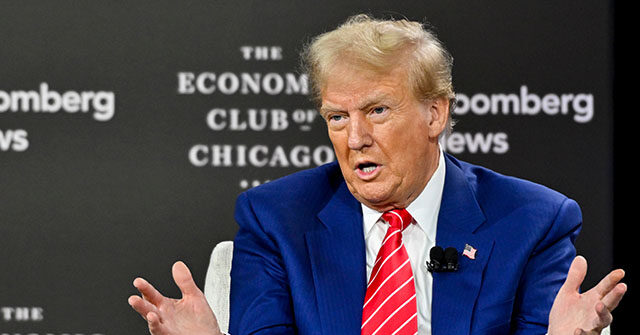In a recent discussion at the Economic Club of Chicago, former President Donald Trump emphasized the significance of tariffs within his economic vision, branding it as “the most beautiful word in the dictionary.” This proclamation came during an interview with Bloomberg Editor-in-Chief John Micklethwait, who contrasted Trump’s engagement with the venue to Vice President Kamala Harris’s refusal to participate in a similar discussion about her economic policies. Trump characterized the primary distinction between his economic approach and that of Harris as a commitment to growth, asserting that his administration sought to revitalize American industry by bringing companies back to the U.S. and taking decisive actions to stimulate the economy.
Trump illustrated his point by referencing the numerous abandoned manufacturing sites across the country, emphasizing that transforming these spaces into senior living facilities does not contribute to economic revitalization. He expressed a strong desire to bring manufacturing jobs back to the United States and proposed further tax incentives for companies that choose to produce domestically. The former president underscored his belief in tariffs as a vital tool for achieving this objective, stating that they would protect American companies from foreign competition, particularly from China, which he accused of seeking to undermine American industry by establishing production facilities in Mexico.
Throughout the conversation, Trump passionately defended his stance on tariffs, framing them as necessary for American economic growth. He asserted that without strong tariffs, American industries would continue to lose out, as foreign companies could take advantage of lower production costs abroad and sell their goods in the U.S. without facing comparable regulatory or taxation burdens. Trump criticized current policies and practices that allow companies to set up operations in other countries, citing the example of a friend who abandoned plans to build a plant in Mexico upon seeing Trump’s rising popularity, suggesting that strong trade policies would alter business decisions in favor of American manufacturing.
When Micklethwait challenged him on the potential negative effects of tariffs, Trump shifted the narrative by framing those effects as positive for domestic manufacturing. He argued that higher tariffs incentivize companies to relocate their operations to the U.S. to avoid paying these tariffs, thus contributing to job creation and economic growth. As he continued to elaborate on his economic philosophy, Trump’s responses received enthusiastic support from the audience, indicating a shared agreement with his pro-tariff stance. He acknowledged the challenges in changing long-standing economic narratives but maintained that his perspective offered a fresh and positive approach.
The former president’s rhetoric highlighted a larger theme within his economic vision: a desire to reclaim American manufacturing as a cornerstone of economic strength. He encourages a return to a manufacturing-centric economy by incentivizing companies to produce locally rather than offshore. Trump’s unabashed promotion of tariffs reflects a broader populist sentiment that resonates with many Americans who have witnessed the decline of manufacturing jobs and the economic challenges it has created within industrial regions. By interweaving narrative anecdotes and statistics about American economic decline, Trump framed tariffs as a crucial part of the strategy to restore American industry’s former glory.
In conclusion, Trump’s remarks at the Economic Club of Chicago underscore his continued focus on tariffs as a critical component of economic policy aimed at fostering growth and restoring American industry. His confrontational stance against free trade, particularly concerning countries like China, illustrates a persistent commitment to revitalizing the U.S. manufacturing base. As he proposes tax incentives alongside strong tariffs, Trump positions himself as a champion for American jobs and industries, contrasting his vision with perceived shortcomings in the current administration’s economic approach. This focus on growth, manufacturing resurgence, and protective tariffs outlines a clear path he believes will benefit the American economy in a competitive global landscape.

